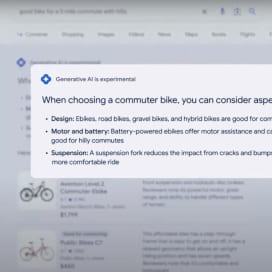Written by Fernando Maciá
Índice

Advantages of the new international content marking
Among the advantages of this new content labeling are the following:
- Position country-specific URLs, even if there are several versions of the same content in the same language: For example, an e-commerce Web site may have the same product sheet in English with only the price and currency varying with three different URLs for the United Kingdom, Ireland and the United States, for example. Until now, it was difficult to control which URL would appear in first place for searches made from each country. The new tagging should ensure that the correct URL for that market is displayed for searches made from each country.
- Prevent content in the same language for different countries from being detected as duplicate content: this theoretically reduces the possibility of being penalized for this reason or, at least, the URLs that we want to position precisely in one country to pass to the supplementary results index.
- In coordination with rel=”canonical”, we can also specify a reference URL with respect to content (for example, the default English version of a page) while specifying which specific URL should be positioned as a result in searches made from each country.
International labeling applications
This new type of marking has obvious advantages for the working scenarios of all international portals in which multi-language and multi-country versions can converge, since it allows us to indicate to Google the URLs to be positioned in each local version of the search engine, reduces the risk of duplicate content detection for multiple versions of the same content in languages common to several countries (for example, in English for countries such as Ireland, the United Kingdom, Australia or Canada, or when there is also a generic English version for the rest of the languages) and should result in a better positioning of all content at a global level.
It should be a definitive solution for local positioning of the right pages on e-commerce sites where the same products are displayed in the same languages but with different prices for each country.
How is it implemented?
The way this new tagging recommended by Google works is as follows. For example, let’s suppose that at www.dominiointernacional.com we have the following URLs:
- http://www.dominiointernacional.com/en/widgets.html
- http://www.dominiointernacional.com/en-IE/widgets.html
- http://www.dominiointernacional.com/en-UK/widgets.html
All of them are basically aimed at the same content. On the one hand we have option 1 with the default English version of the content. And we have options 2 and 3 of the same content with two different URLs focused on two different countries: Ireland and UK.
Recommendations for international versions of a Web site (so far)
Until now, the way to try to control which URLs Google ranked for each country consisted of geolocating each subdirectory (/en/, /en-IE/, /en-UK/) from Google Webmaster Tools to its corresponding country and trying to generate popularity to those URLs from other geolocated domains in the country we were interested in. I.e. links from Irish domains for URLs in the /en-IE/ subdirectory, links from British domains for URLs in the /en-UK/ subdirectory, etc.
In this scenario, Human Level Communications recommended that, if it exists, the generic subdirectory of English content /en/ should not be geolocated for any specific country since it is the default English content of the portal and we do not want a specific positioning of such content in a specific country, but in any search made in English from any country in the world. On the other hand, the subdirectories /en-IE/ and /en-UK/ should be geolocated to Ireland and Great Britain, respectively.
However, this strategy generated very uneven results in terms of international positioning. In most cases, Google detected the content in the general portal before the country portals, which is a sign of the original -canonical- source of the content. On the other hand, the popularity of the general portal content tended to be higher than that of country-specific portals. Both signals favored that even for searches made from different countries, the contents of the general portal in English ranked better than the equivalent contents of the portal specifically oriented to a particular country.
New recommendations for international versions of a Web site
In this scenario, the tagging now recommended by Google would involve including the following lines of code in the <HEAD> header section of each of the above URLs:
For http://www.dominiointernacional.com/en/widgets.html:
<link rel=”alternate” hreflang=”en-IE” href=”http://www.dominiointernacional.com/en-IE/widgets.html” />
<link rel=”alternate” hreflang=”en-UK” href=”http://www.dominiointernacional.com/en-UK/widgets.html” />
For http://www.dominiointernacional.com/en-IE/widgets.html:
<link rel=”alternate” hreflang=”en” href=”http://www.dominiointernacional.com/en/widgets.html” />
<link rel=”alternate” hreflang=”en-UK” href=”http://www.dominiointernacional.com/en-UK/widgets.html” />
For http://www.dominiointernacional.com/en-UK/widgets.html:
<link rel=”alternate” hreflang=”en” href=”http://www.dominiointernacional.com/en/widgets.html” />
<link rel=”alternate” hreflang=”en-IE” href=”http://www.dominiointernacional.com/en-IE/widgets.html” />
Additionally, we can also include rel=”alternate” to indicate to Google the versions of other languages and localizations of a page, if they exist, so in each of the above we could also add, for example, references to other versions of the content that our Web has for other countries and languages in the following way:
<link rel=”alternate” hreflang=”en” href=”http://www.dominiointernacional.com/es/widgets.html” />
<link rel=”alternate” hreflang=”fr” href=”http://www.dominiointernacional.com/fr/widgets.html” />
<link rel=”alternate” hreflang=”de” href=”http://www.dominiointernacional.com/de/widgets.html” />
<link rel=”alternate” hreflang=”en-MX” href=”http://www.dominiointernacional.com/es-MX/widgets.html” />
Etc.
In the case of international portals where a large number of different language and country versions coexist, specifying all the versions of a page could add a lot of code to the <HEAD> There are also ways to specify these instructions through HTTP headers configured on the server, or to decide which are the minimum alternative versions to specify in each case.
Additional references
In the following links you can consult the most relevant documentation published by Google on the marking of international versions of content on international websites.
- https://developers.google.com/search/blog/2011/12/new-markup-for-multilingual-content?hl=es
- https://webmasters.googleblog.com/2010/09/unifying-content-under-multilingual.html
- https://support.google.com/webmasters/answer/189077?hl=es
- https://www.humanlevel.com/blog/seo/seo-internacional-claves-para-posicionar-tu-sitio-en-otros-paises.html



